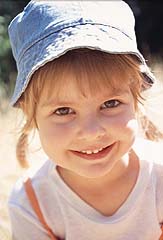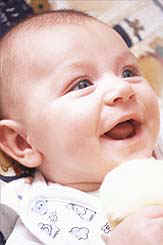Cochlear Implant Innovations & Research
New Innovations in Cochlear Implantation
UC Irvine cochlear implant program is currently the largest cochlear implant program in Orange County and one of the largest in Southern California treating both adults and pediatric patients. The program implants all available devices in the U.S. and currently implants patients with residual hearing as well as patients with single-sided deafness. The team has one of the best hearing preservation rates in the U.S. In addition, the facial nerve and chorda tympani nerve preservation are among the best in the country. This has led patients from other areas including out of state patients seeking their surgery at UC Irvine.
The team has developed a novel techniques in surgery to preserve hearing which has resulted in the patients' ability to use a combination of hearing aid for low-frequency hearing and the cochlear implant for high-frequency hearing. Research at UC Irvine Center for Hearing Research has found that bimodal hearing (hearing aid and cochlear implant) results in better speech perception.
We do 70-100 implants per year. Immediate postoperative hearing preservation rate of 100% on Hybrid implants and 80% on full-length Cochlear or Advanced Bionics implants. We have 100% facial nerve and 99% chorda tympani nerve functional preservation.
Placement of bilateral cochlear implantation
There has been some recent reports that indicate improved performance with the placement of bilateral cochlear implants. The placement of the cochlear implant bilaterally requires special expertise and some special equipment. The UC Irvine research team is working with a large group of patients with bilateral implants to understand the possible advantages of bilateral implants.
Placement of cochlear implants in children younger than the age of 12 months
Cochlear implants have been approved by the FDA for patients who are 12 months or older. In special circumstances, patients under the age of 12 months can be implanted. In these patients, cochlear implants have been placed with great success. Patients who develop meningitis before the age of 1 year are patients who are implanted at the younger age.
Cochlear Implantation in Patients Over the Age of 60
In the late 1990s, Dr. Djalilian performed a study looking at the effects of cochlear implantation in the patients over the age of 60. His study found that the benefit to the older patients is just as good as a group of adults under the age of 60. The patients’ improved quality of life was also equal to the control subjects. The conclusion of this important study was that older patients benefit greatly from the placement of a cochlear implant. This study was part of the studies used to justify the coverage of cochlear implants by Medicare.
The oldest patient implanted by Dr. Djalilian was 94 years old at the time of the implantation and continues to be a regular user. He describes being able to hear his grandchildren as a “Gift”. He says that he is able to interact socially and no longer feels the loneliness that comes with deafness.
Research at the UC Irvine Cochlear Implant Center
Under the direction of the world renowned Cochlear Implant researcher, Fan-Gang Zeng, Ph.D., ground breaking cochlear implant research is ongoing at UC Irvine. Patients from all over the U.S. are participating in the innovative research designed and implemented at UC Irvine. These ongoing projects include:
- Developing coding strategies to improve the listening to music
- Coding strategies to eliminate tinnitus. UC Irvine researchers are the first to successfully program a special coding strategy specifically for elimination of tinnitus (ringing in the ears) in a patient undergoing cochlear implantation for tinnitus.
- Using ultra-high rate stimulation to closely mimic the stimulation that occurs in the normal cochlea.
- Innovative coding strategies for better understanding of speech in noise.
- Comparison of patients with bilateral cochlear implants to those with a cochlear implant on one side and a hearing aid on the other.
- Developing strategies for a cochlear implant sound simulator
Click here for more research information at Dr. Zeng's laboratory website.
Other ongoing cutting edge collaborative research at UC Irvine:
- Collaboration with the Department of Mechanical and Aerospace Engineering, Dr. Andrei Shkel , on the world's first implantable vestibular implant (a device to replace the balance function).
- Collaboration with Drs. Li and Bachman at the Integrated System Technology Solutions Laboratory at UC Irvine for design of a new generation of cochlear implants
- Collaboration with UC Irvine Micro-Electro-Mechanical-Systems (MEMS) Center Micromechanics Laboratory , Dr. William Tang, on the design of a new generation of cochlear implant electrode.
- Collaboration with world-renowned Auditory Neuropathy researcher, Dr. Arnold Starr, on understanding and treating auditory neuropathy. Dr. Starr is the first researcher to discover the cause of auditory neuropathy. See here for story.
The Cochlear Implant Research Team is part of the Center for Hearing Research at UC Irvine. Members of the Hearing Research Team are listed below. For more information on the Center for Hearing Research click here .
Bruce G. Berg
Associate Professor, Cognitive Sciences
Interests: perception of complex sounds; mathematical modeling of psychophysical and physiological auditory processes.
Anne L. Calof
Professor, Anatomy & Neurobiology
Interests: Molecular analysis of nervous system development and regeneration using transgenic mouse models; neural stem cells
Karina S. Cramer
Assistant Professor , Neurobiology & Behavior
Interests: We study the cellular and molecular mechanisms that underlie formation of neural circuitry in the auditory system during embyrogenesis, and we examine how these mechanisms operate during plasticity.
Nicole Gage
Assistant Researcher, Cognitive Sciences
Interests: Neural substrates of human speech and language.
Gregory S. Hickok
Professor, Cognitive Sciences
Interests: We use a variety of methods (fMRI, lesion, TMS) to map brain systems supporting speech and language processing, in both hearing and deaf populations.
Leonard M. Kitzes
Professor, Anatomy & Neurobiology
Interests: Physiology and development of the auditory system.
Virginia Mann
Professor, Cognitive Sciences
Interests: Reading ability: phoneme awareness, developmental dyslexia, phonological skills, early intervention precocious readers speech perception: context effects, cross-linguistic comparisons.
Raju Metherate
Associate Professor, Neurobiology & Behavior
Interests: Mechanisms of auditory cortex physiology, development and modulation.
Kourosh Saberi
Associate Professor, Cognitive Sciences
Interests: Cortical bases of sensory and perceptual processes.
Arnie Starr
Research Professor, Neurology, Neurobiology & Behavior, Cognitive Sciences
Interests: We study altered auditory processes in normal subjects and in 1) auditory neuropathy, a disorder of auditory nerve function in the presence of normal hair cell functions; 2) auditory memory and attention and changes with aging and dementias. We use physiological brain potentials measures of auditory pathway activity from the hair cell to auditory cortex to localize the site of change in the auditory pathway.
Norman M. Weinberger
Professor, Neurobiology & Behavior
Interests: Our goals are to understand the acquisition, retention and representation of information in the primary auditory cortex that underlies behavioral memory. We use a multi-level approach: behavioral, systems, circuits and cells. We are currently studying specific memory traces in auditory cortex and behavioral memory induced during both learning and by activation of the cholinergic nucleus basalis, and the new field of memory codes, the latter appearing as tuning shifts that encode the magnitude of learned behavioral importance of sounds.
Jack Xin
Professor, Mathematics
Interests: Fronts in heterogeneous media, ear modeling, and sound signal processing.
Fan-Gang Zeng
Professor, Otolaryngology, Anatomy and Neurobiology, Biomedical
Engineering, and Cognitive Sciences
Interests: Use systems and modeling approach to understand how the ear and the brain work together to process sounds, including human speech and music. Develop and design innovative prosthetic devices and training procedures for people who have lost hearing and balance functions.
Why Come to UC Irvine Cochlear Implant Center?
 The UC Irvine team has strived to provide the best care for the patients. Clinicians and researchers at the center are doing research to understand how the performance of cochlear implants can be improved. Significant milestones achieved by the members of the UC Irvine team.
The UC Irvine team has strived to provide the best care for the patients. Clinicians and researchers at the center are doing research to understand how the performance of cochlear implants can be improved. Significant milestones achieved by the members of the UC Irvine team.
- 5 patents in the invention of the cochlear implant
- Introducing Music to the Bionic Ear
- Optimizing cochlear implant stimulation to suppress tinnitus
- Collaboration with the world-renowned engineering and nano-technology center has micro-machined a piano for use in future cochlear implants.
- First cochlear implant performed under local anesthesia in the U.S.
For a list of selected publications on cochlear implants from members of the team, click here .
Publications
Selected Publications for Dr. Djalilian
Djalilian HR, Roy S, Benson AG, Regala C, Leman T, McDonald TA. Transcanal cochlear implantation under monitored anesthesia care. Otology and Neurotology 26(4) July 2005 pp 674-677
Rayner MG, King T, Djalilian HR, Smith S, Levine SC. Resolution of facial stimulation in otosclerotic cochlear implants. Otolaryngol Head Neck Surg. 2003 Nov;129(5):475-80.
Djalilian HR, King TA, Smith SL, Levine SC. Cochlear implantation in the elderly: results and quality-of-life assessment. Ann Otol Rhinol Laryngol. 2002 Oct;111(10):890-5.
Zheng Y, Schachern PA, Djalilian HR, Paparella MM. Temporal bone histopathology related to cochlear implantation in congenital malformation of the bony cochlea. Otol Neurotol. 2002 Mar;23(2):181-6.
Djalilian HR, King T, Faust RA, Smith S, Levine SC. Securing cochlear implants to the skull: two alternate methods. Ear Nose Throat J. 2001 Mar;80(3):171-3.
For a full list of Dr. Djalilian's Publications through PubMed, click here .
Selected Publications for Dr. Zeng
Nie K, Barco A, Zeng FG. Spectral and temporal cues in cochlear implant speech perception. Ear Hear. 2006 Apr;27(2):208-17.
Shkel AM, Zeng FG. An electronic prosthesis mimicking the dynamic vestibular function. Audiol Neurootol. 2006;11(2):113-22. Epub 2006 Jan 17.
Bachman M, Zeng FG, Xu T, Li GP. Micromechanical resonator array for an implantable bionic ear. Audiol Neurootol. 2006;11(2):95-103. Epub 2006 Jan 17.
Tang Q, Liu S, Zeng FG. Loudness adaptation in acoustic and electric hearing.
J Assoc Res Otolaryngol. 2006 Mar;7(1):59-70. Epub 2006 Jan 20.
Stickney GS, Nie K, Zeng FG. Contribution of frequency modulation to speech recognition in noise. J Acoust Soc Am. 2005 Oct;118(4):2412-20.
Vongphoe M, Zeng FG. Speaker recognition with temporal cues in acoustic and electric hearing. J Acoust Soc Am. 2005 Aug;118(2):1055-61.
Kong YY, Stickney GS, Zeng FG. Speech and melody recognition in binaurally combined acoustic and electric hearing. J Acoust Soc Am. 2005 Mar;117(3 Pt 1):1351-61.
Michalewski HJ, Starr A, Nguyen TT, Kong YY, Zeng FG. Auditory temporal processes in normal-hearing individuals and in patients with auditory neuropathy. Clin Neurophysiol. 2005 Mar;116(3):669-80. Epub 2004 Nov 25.
Starr A, Isaacson B, Michalewski HJ, Zeng FG, Kong YY, Beale P, Paulson GW, Keats BJ, Lesperance MM. A dominantly inherited progressive deafness affecting distal auditory nerve and hair cells. J Assoc Res Otolaryngol. 2004 Dec;5(4):411-26.
For a full list of Dr. Zeng's Publications through PubMed, click here .
Selected Publications for Dr. Lin
Battaglia A, Lualhati A, Lin H, Burchette R, Cueva R. A prospective, multi-centered study of the treatment of idiopathic sudden sensorineural hearing loss (ISSNHL) with combination therapy vs. high dose prednisone alone: a 139 patient follow-up. Otology & Neurotology 25, 1091 (2014)
Roberts DS, Lin HW, Herrmann BS, Lee DJ. Differential cochlear implant outcomes in older adults. Laryngoscope 123, 1952 (2013)
Roberts DS, Lin HW, Bhattacharyya N. Health care practice patterns for balance disorders in the elderly. Laryngoscope 123, 2539 (2013)
Lin HW, Furman AC, Kujawa SG, Liberman MC. Primary neural degeneration in the guinea pig cochlea after reversible noise-induced threshold shift. Journal of the Association for Research in Otolaryngology 12, 605 (2011)
Lin HW, Bhattacharyya N. Otologic diagnoses in the elderly: current utilization and predicted workload increase. Laryngoscope 121, 1504 (2011)
For a full list of Dr. Lin's Publications through PubMed, click here.

